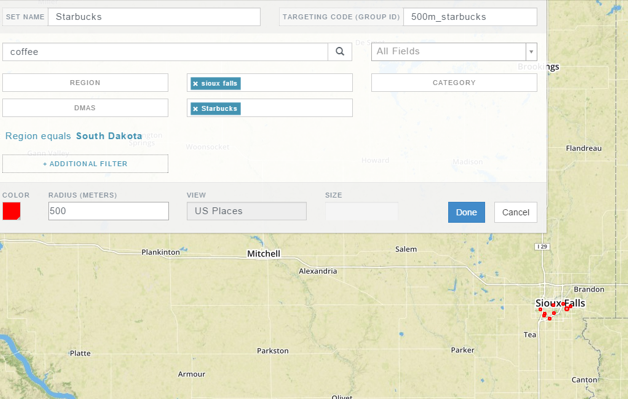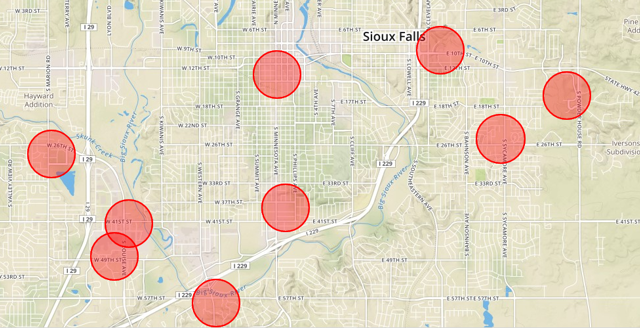
The targeting capabilities of online marketing make it easy for businesses to focus their advertising budget on people who are more likely convert sales. Search, Contextual, Audience, and Channel Targeting offer today’s businesses the chance to precisely define their ideal customer, but we could soon be adding another, even more precise, targeting option to the list.
Imagine if you could serve a potential customer one of your ads as soon as they get within walking distance of your business. Or, imagine serving ads to potential customers as they’re in your competitor’s building. A new ad targeting technology called Geofencing is able to serve your ads to customers who are within meters of your business.
In this blog, we’re going to take a look at Geofencing, and breakdown how it works. Find out why Geofencing could be the next big online advertising tactic for your business.
What Is Geofencing?
Geofencing uses the Global Positioning System (GPS) to build virtual boundaries around specific locations. As recent as 3 years ago, you would have needed a beacon located in your store in order to use Geofencing. Along with the beacon, your potential customers would also have needed to have an app on their mobile devices that would allow them to receive your ad. But now you can use Geofencing to reach anyone within a narrow scale ranging anywhere from 1 to 30,000 meters without any beacons or apps. Once a customer is within the parameters that you’ve set, a Real-Time Bidding process will occur and there’s a chance that they will see your ad while they’re using their mobile devices to surf the web.
Geotargeting delivers ads to devices based on their geographic location and specific audience parameters. Geotargeting has the ability to target larger locations based on different parameters such as cities or zip codes. An advertiser would want to use Geotargeting when the client wants to target people in a city such as Sioux Falls, in addition to anyone within a 50 mile radius of the city.
Geofencing and Geotargeting are similar but there are differences. Geofencing is able to create advertising opportunities within much more defined areas.
The Process
In order to best explain the targeting capabilities and process of a business using Geofencing, let use an example to illustrate how it would work. Let’s use a local Starbucks in our example.
If Starbucks launched a new food item and wanted to show it to people in and near their stores, the first thing we would need to find out is the different locations they want to target. Since our Starbucks is in Sioux Falls, SD, we’ll start by setting parameters of 500 meters around each location.
Below is an image of the multiple Starbucks locations is Sioux Falls, SD and the targeting rang we’ve decided for this example.

A closer look shows us the proximity of each Geofence around the different locations. We would then adjust the size of the Geofence depending on how targeted the client wants their ads to be served. If you wanted to limit the Geofencing and only reach people in or within walking distance of a single Starbucks, we would make a smaller Geofence. However, if wanted to broaden our target area and reach people in the general vicinity of a Starbucks, we would make a larger Geofence.

Geofencing Conquest
Let’s say that as a part of Starbucks’ campaign, they would like to target all of their competitors that are listed as Cafes, Coffee, and Tea Houses. By creating a Geofence 50 meters around the various businesses that fall into that category in Sioux Falls, we can serve ads to people who are in those areas. All of the blue locations within the red circle represent Starbucks’ competitors who are within a close enough distance to serve ads.

Using the Geofencing parameters we’ve setup, we can see that there would be multiple competitor’s shops that fall within our target area. Because those locations are close enough to our Starbucks’ shops, when potential customers walk into competing locations they will be served an ad featuring Starbucks’ new item/deal. Now the customer is made aware of not only Starbucks’ item/deal, but also that they are within walking distance to the closest Starbucks.
Narrowing Your Targeting
We can continue to narrow our targeting options. Starbucks could directly target specific competitors instead of the ones that fall within their Geofence. We would repeat the Geofencing process, but only select a certain area around all of the Caribou Coffee shops in Sioux Falls.
Because of the large number of coffee shops in Sioux Falls, using Geofencing to target specific competitor locations can give Starbucks another advantage in their industry.

Stay Top of Mind
We always want to stay in front of your potential customers after they’ve left the fence you’re targeting. After a customer has left your Geofence, continue to show them ads that remind them why they should visit your business.
This tactic works best when we build multiple, large fences that have run for more than two weeks. This technology, Retargeting, isn’t new to the advertising world. However, the ability to retarget to people who’ve walked into a Geofenced area is new to Mobile Advertising. With traditional retargeting, a user would have to visit a website or a landing page in order to be added to a retargeting list and served an ad at a later date. Combining retargeting with your Geofence campaign is a sure-fire way to reach a specific audience and bring attention to your business. But what’s next?
Start Fencing
The next wave of Mobile Advertising is looking will be an interesting one. In this fast-paced world, all of the new technologies including Geofencing are making it easier for businesses to reach their customers while they’re on the move. Businesses that take part in the cutting edge targeting capabilities of tactics like Geofencing open themselves up to potential customers in a new way.
If you’re interested in learning more about Geofencing or other mobile advertising technology, contact us today to start targeting new customers. You can also download out free Mobile Advertising Whitepaper by clicking the image below.